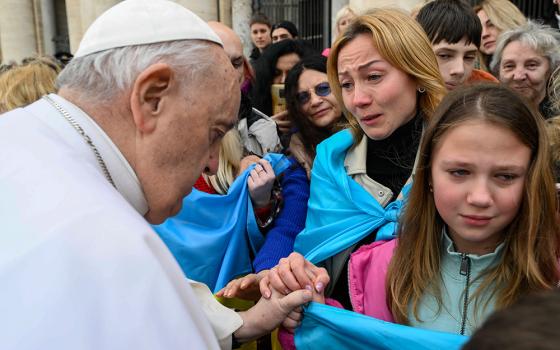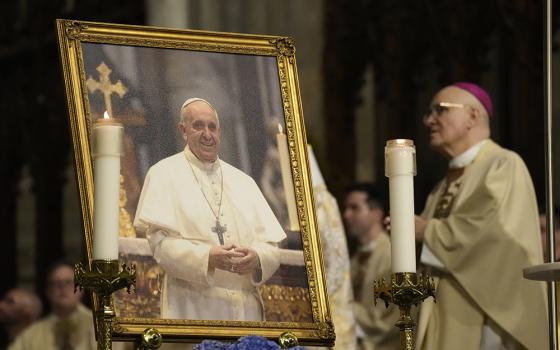In continuing our examination of Tracey Rowland’s book, “Ratzinger’s Faith,” begun yesterday, we turn as she does to one the Second Vatican Council’s most emblematic documents, the Pastoral Constitution on the Church in the Modern World, or Gaudium et Spes. Even the title of the document was novel: The document was not, like Lumen Gentium, a doctrinal constitution, but because the Council Fathers wanted to highlight its significance they devised this hybrid name, a pastoral constitution.
How one reads Gaudium et spes is likely to tell one a lot about where you will end up on a variety of issues. Ratzinger, already in 1966, tried to bridge the already emerging divergence between more progressive and more conservative readings, writing that the idea of renewal of the Church entailed a “twofold intention” – “its point of reference is contemporary man in his reality and in his world, taken as it is. But the measure of its renewal is Christ, as scripture witnesses Him.” This Christocentric focus will seen to be key in understanding Ratzinger’s interpretation of the Council, but this focus was not in focus throughout the Church.
The dominant interpretation in the post-conciliar years, however, was different. Many, most especially Rahner, saw the Council as a break in time, which poses difficulties if over-stated, but the real difficulty lay elsewhere. Rowland writes, “The Council was popularly construed as a mandate from the Holy Spirit to accommodate the Church’s practices (and for some even its teaching) to the norms and rapidly changing mores of contemporary society. The Conciliar call to discern the signs of the times was received as a call to adopt and assimilate them.” Rowland then relates the famous encounter between Karl Barth and Pope Paul VI in 1966, in which Barth asked the pontiff, “What does aggiornamento mean? Accommodation to what?”
Not all of the blame for the rush to embrace modern culture indiscriminately can be attributed to the Rahnerian school nor to Hans Kung’s increasingly controversial writings. The pre-conciliar theology, so allergic to historical considerations and clinging in an intellectual ghetto to its neo-scholastic syllogisms, had not provided the Church with the kind of intellectual groundwork it needed for the encounter with modernity. Certainly, few of the Council fathers understood that modernity itself, as an intellectual construct, was collapsing under its own weight. Rowland quotes historian John O’Malley, S.J., no conservative, on this point: “At the time of the Council we did not think to ask from it any consistent theoretical foundations for aggiornamento, because most of us were not aware of the importance of having one.”
Ratzinger’s problems with Gaudium et spes were contemporary and they centered around the dualism we discussed yesterday. “The text was still based on a schematic representation of nature and the supernatural viewed far too much as merely juxtaposed” Ratzinger wrote, and that the text started with “the fiction that it is possible to construct a rational philosophical picture of man intelligible to all and on which all men of goodwill can agree, the actual Christian doctrines being added to this as a sort of crowning conclusion.” If you doubt this critique remains relevant, check out the text of George Weigel’s address to the graduating class at Benedictine College. Ratzinger, who knows how to turn a phrase, subsequently asked of Gaudium et spes, “why exactly the reasonable and perfectly free human being described in its first articles should suddenly be burdened with the story of Christ?”
Indeed, one of the central paradoxes of Gaudium et spes flows from this persistent dualism. Gaudium et spes is at pains to acknowledge the autonomy of various sectors of human life. The Council accepted what Ratzinger calls a “fundamental concept of the modern age” namely that “secular matters are to be decided in a secular fashion, political matters in a political fashion, economic matters in an economic fashion.” But, so far from erecting a bridge between the Church and the modern world, this way of looking at the world actually severs the two. Are there really realms of human endeavor that exist apart from Christ’s salvific mission? As mentioned yesterday, it is all well and good to quote the biblical account of Jesus telling the Pharisees to render unto Caesar the things that are Caesar’s and to God the things that are God’s, but does not scripture also say, “All was created by Him, and for Him”? This Christocentric focus found its way into the text of Gaudium et spes: “The truth is that only in the light of the incarnate Word does the mystery of man take on light.” (GS 22) As I have noted before, this is the single conciliar text cited by Pope John Paul II more than any other in his many encyclicals. How it sits with the parts of Gaudium et spes that reflect a more dualistic approach is the heart of the matter and no amount of textual analysis or historical sniffing can resolve it. Here is the task for theology and that task is urgently needed by the U.S. bishops for whom the treatment of the subject of human freedom in Gaudium et spes was one of Raztinger’s most persistent concerns.
Rowland moves in to consider Ratzinger’s views on Revelation, Scripture and Tradition. This chapter is the most dense of them all, at least for me. But, among the key insights, two jump out. First, Christianity is a way of life and therefore a way of thinking: “His general catechetical principle is that the way of knowledge that leads to God and to Christ is a way of living,” Rowland writes. “In order to know Christ it is necessary to follow him. In this his position is very Augustinian (the practice of the faith leads to dunerstanding) and here again it echoes much that has been written about the relationship between traditions and practices by [Alisdair] McIntyre. Where McIntyre links virtue to practices and practices to knowledge of a Tradition, Ratzinger links the theological virtues to Christian practices and Christian practices to participation in the life of the Trinity.” I believe truly that if more preachers spoke about the Christian vocation as an invitation to participate in the divine life of the Trinity, rather than in the dualistic claims about a sound, reasonable accessible, natural law with a Christian cherry on top, our Church would be better at keeping her members and much better able to engage the culture.
The second key point in this chapter is the way, albeit ironically, Raztinger comes to some of the same conclusions of post-modernists regarding modernity’s emphases on pure-Kantian or geometric-Cartesian or Darwinian-naturalist reason, all of which have come a cropper. Modern notions of reason are reductionistic insofar as they close off that openness to the transcendent that is at the heart of both Jewish and Christian thinking about human reason. Unsurprisingly, the congruence between the post-modernists and Raztinger is short-lived. “[T]he logic of Raztinger’s position is that the choice is between Christianity and nihilism, “Rowland writes. “Both have their own internal logic. Both have their own God or gods and their own myths. The Christian God takes the form of absolute love, whereas the alternative gods are violent or selfish or both. What Raztinger calls the ‘evolutionary ethos’ of those who would deny that the human person is made in the image and likeness of God is not only wrong but cruel.”
Ratzinger is clear that the decision to follow Christ is not only first and foremost a response to God’s invitation, but that it is a very reasonable thing to do. He gives reason its due, just not modern, crimped notions of rationality. And, unlike the pre-conciliar scholastics, he is keenly attentive to the role of history in all this. Here I wish Rowland had gone a little deeper. It has been a long time since I read Ratzinger’s “Introduction to Christianity” but I recall that he wrestles with Vico in that book and, it seems to me, that we learn a great deal about contemporary critics of the Enlightenment by discerning how they treat earlier critics of the Enlightenment. Vico, of course, was, with Hamann and Herder, the focus of Sir Isaiah Berlin’s great masterpiece “Three Critics of the Enlightenment.” I am sure that Berlin’s treatment was different from Raztinger’s, but I am also sure that exploring those differences, and the instances where they agree, would make for some fascinating reading. Alas, also for writing that is far above my intellectual skills.
Tomorrow, I will conclude this series on Ratzinger’s faith. Almost anytime, and on any subject, the more we learn about the subject, the more likely we are to avoid facile judgments. Knowledge can upset narratives as well as confirm them. Learning about Raztinger’s theology is not important only because he happened to end up as Pope. It is important in piercing through – and moving beyond – the stale debate between Christian progressives and Christian traditionalists that have marked the post-conciliar era.




